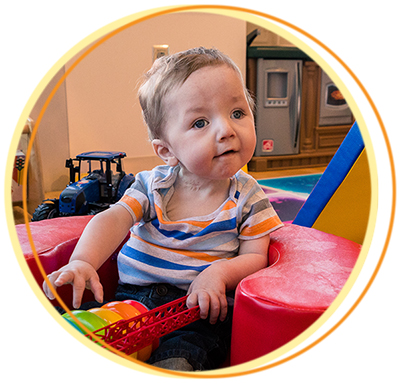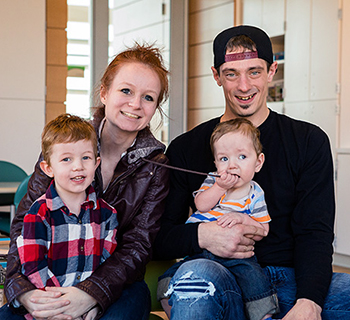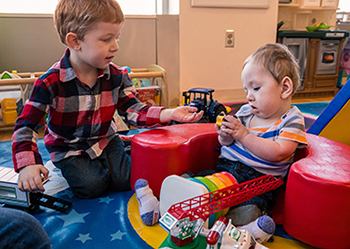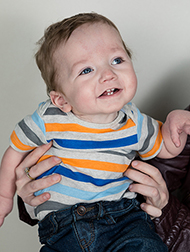Bentley Beardslee
Team Comes Together to Save Newborn Facing Rare, Life-Threatening Condition
The night before her scheduled C-section, Courtney Swetman stood over her sink at 2:00 a.m., alternating scrubbing dishes and rubbing her back. At 37 weeks pregnant, she was physically and mentally exhausted, but she couldn’t sleep, and the activity took her mind off of what was to come.
 “It didn’t really hit me until then,” said Courtney. “I had been trying to hold it together for everybody else.”
“It didn’t really hit me until then,” said Courtney. “I had been trying to hold it together for everybody else.”
Like all expectant mothers, Courtney had been anxiously waiting for this day. But she had an especially good reason to be restless: Her baby boy had a rare condition that would make his birth the next morning extremely complex. It was so problematic that doctors had been preparing and planning his birth for months — even rehearsing it, multiple times.
“This was one of the most complicated births I have ever been a part of,” said neonatologist Kristin Scheible, M.D. “We knew things could go south, really fast. So we had to be prepared.”
Trusting the Team
Maternal-Fetal Medicine specialists from UR Medicine Perinatology first discovered that something was wrong at Courtney’s 20-week ultrasound. Her baby, who she planned to name Bentley, had a mass on one of his lungs.
“They said that it could get bigger and be really bad, or it could get smaller, and go away,” said Courtney. “It was scary, but we just tried to be optimistic.”
But the mass grew.
And grew.
And grew.
For the rest of her pregnancy, Courtney visited the Perinatology team — the largest in the region — frequently. Using Level II ultrasound capabilities and fetal MRI imaging, doctors followed the mass closely, monitoring its growth and watching for complications.
Eventually, the mass took up a large portion of Bentley’s chest, pushing his heart and organs out of the way and making it difficult for them to function. Doctors warned Courtney and Rob that their baby might pass away before he was born, and if he survived, his prognosis might be bleak.
The team offered Courtney and Rob the option to deliver their baby at another facility out of state, where doctors can treat conditions like Bentley’s during pregnancy. But Courtney had a 2-year-old son, and she and Rob couldn’t move their family away from their home in Lima for months while they waited for Bentley to arrive.
“We looked at our options, and what was going to be the best outcome for our family,” said Courtney. “In the end, I had to trust the people that were here.”

Bentley with his parents, Courtney and Rob, and big brother Kayden.
Practice Makes Perfect
Laura Price, M.D., who was a trainee in the neonatology fellowship at the time, and Kathryn Drennan, M.D., an obstetrician and Maternal-Fetal Medicine specialist from UR Medicine Perinatology, brought together a team of doctors from a dozen different services to meticulously plan every detail of Bentley’s birth and treatment.
First, doctors decided that Courtney would be the first mother to deliver a baby in the children’s hospital, instead of the obstetrics floor at Strong Memorial Hospital, where women usually give birth. The team wanted to be able to transport Bentley — emergently if necessary — to a pediatric operating room, where surgeons would attempt to remove the mass on his lung.
Next, the team consulted with colleagues around the country to get their input on how to manage the delivery. Then, they decided who needed to be in the operating room — including specialists in everything from radiology to otolaryngology — and exactly where they were going to stand.
“Because we needed so many different providers to care for Courtney and Bentley, we even planned how we were going to communicate and what we were going to say,” said Scheible. “It was extremely well-choreographed.”
Doctors then simulated the birth in the operating room with a mannequin, rehearsing it six times before they felt confident that they knew exactly what to do once Bentley was born.
“It was the most planning I have ever seen,” said pediatric surgeon Derek Wakeman, M.D. “The team considered every outcome possible.”
Bentley’s Arrival
Doctors had a separate — but just as detailed — backup plan that they aimed to use if Courtney went into labor prematurely. But, luckily, she didn’t, and on March 13, 2018, she gave birth to her baby boy.
Because of the size and location of Bentley’s mass, his team expected he wouldn’t be able to breathe sufficiently on his own. So Price and Drennan led doctors in performing an “EXIT” procedure that had not been used at the children’s hospital in more than 10 years.
After the Maternal-Fetal Medicine team used a special device to open the womb, they partially delivered Bentley to his shoulders. Then, before the delivery was completed — while Bentley was still receiving oxygen from his mother through the placenta — otolaryngologist Margo Benoit, M.D., inserted a breathing tube. After his oxygen support was secured, the team cut his umbilical cord, completed the delivery, and safely finished Courtney’s surgery.
“Delivering him in this way was critical for a good outcome,” said Drennan. “We knew that Bentley’s heart and lungs were going to have a hard time functioning after he was born, and this procedure helped to stabilize him for delivery as much as possible.”
Courtney and Rob got one good look at him before he was whisked away.
“I heard him crying, and that gave me some hope,” said Rob.
Next door, his surgical team, Wakeman and Walter Pegoli, M.D., were ready. They hoped to delay the surgery so that his heart and lungs would get a chance to adjust to life in the outside world.
But they couldn’t wait too long, either. Every time Bentley’s lungs expanded, the mass trapped more air, making it increasingly difficult for his heart and lungs to do their jobs. Suddenly, his oxygen levels dropped, and the team knew he needed to go to surgery — fast.
“Without that operation, he would have died in that room,” said Wakeman.

Bentley with his big brother Kayden.
An Emotional Rollercoaster
Surgeons successfully removed Bentley’s mass, and he was transported to the Neonatal Intensive Care Unit (NICU). Even though the surgery had gone well, Bentley’s doctors expected that he would still face a lot of challenges.
“His respiratory function still wasn’t normal — so it was very touch and go,” said Rita Dadiz, D.O., a neonatologist who cared for Bentley. “Usually, one nurse in the NICU cares for two or three babies at a time. But Bentley had two nurses, all to himself.”
He made it through that first night, but the next day, his condition started to deteriorate. Doctors knew they were going to have to place him on a special type of life support system — called extracorporeal membrane oxygenation (ECMO) — that would do the work of Bentley’s heart and lungs for him.
Children who need ECMO usually have about a 50 percent chance of survival, and the treatment is often a last resort. But considering what Bentley had already been through, his odds were even longer.
“They told us multiple times to prepare ourselves for the worst,” said Courtney. “It was so difficult. I kept thinking about losing him, and if we did, how we were going to explain what had happened to his big brother, who just wanted Bentley to come home.”
ECMO treatment often leads to complications, and the next few days were a rollercoaster. After nearly three weeks, doctors decided it was time to see if Bentley was strong enough to survive without ECMO.
“We really weren’t sure how it was going to go,” said Scheible. “I was biting my nails, and thinking: Is this going to work?”
But once again, Bentley impressed his care team, and pulled through.

Turning a Corner
Coming off ECMO marked a turning point for Bentley. He wasn’t quite out of the woods yet, but he was stable, and his family was finally able to breathe a sigh of relief.
After five months in the NICU, Bentley went home. He’s now breathing all on his own, and doctors hope to remove his feeding tube soon. In March, he celebrated his first birthday.
During a recent visit to Golisano Children’s Hospital, Bentley sat on the floor, taking in the toys around him before reaching for a toy truck. He turned to get a glimpse of his big brother, Kayden, and hearing his dad’s voice behind him, broke out into a smile.
“Looking at him now, it tears me up to know where he came from,” said Rob. “Every day, we’re amazed by what he’s able to do.”
And there’s no question why he’s here.
“Had that planning not taken place, and had he not been born in the children’s hospital, I’m not sure he would be with us,” said Wakeman. “That’s what saved him.”
Make a Gift to Golisano Children's Hospital
Bentley, age 1, battles rare, life-threatening condition
Bentley, age 1, battles rare, life-threatening condition
13wham.com Special Report by Alexis Arnold